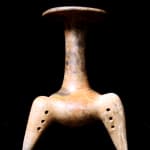Pre-Columbian Tripod Vessel, 800 CE - 1500 CE
ceramic
8 x 10.75 x 8
DE.009 (LSO)
Further images
This attractive glazed tripod vessel is perhaps one of the most emblematic and striking forms to come out of the culturally diverse Mesoamerican region. The vessel itself is a tall,...
This attractive glazed tripod vessel is perhaps one of the most emblematic and striking forms to come out of the culturally diverse Mesoamerican region. The vessel itself is a tall, fluted, columnar construction, with a flat rim projecting perpendicular to the vessel’s long axis. The body is very gracefully tapered to a short, broad body, which flares into three rounded shoulders that then diverge inferolaterally to form a trio of pointed legs. The ground is pale, giving way to a dark brown glaze on the top half of the vessel. The pattern is such that it would seem that the vessel was partially buried, with the spout and neck protruding above the surface. The piece is largely undecorated, thus attracting attention to its graceful and convergent lines. The exception is the band of incised decoration at the base of the neck, and the lines of three holes that are cut into each leg.
The design of this piece is non-diagnostic; the format dates back as far as the Olmecs, albeit in a somewhat different form, and is found across Mexico and the rest of Mesoamerica. However, in balance, it most closely resembles the vessels of a group of archaeological cultures – known almost purely from their artworks – referred to as the Western Mexico Shaft Tomb tradition. All of the cultures encompassed under this nomenclature were in the habit of burying their dead in socially-stratified burial chambers at the base of deep shafts, which were in turn often topped by buildings. Originally believed to be influenced by the Tarascan people, who were contemporaries of the Aztecs, thermoluminescence has pushed back the dates of these groups over 1000 years. Although the apogee of this tradition was reached in the last centuries of the 1st millennium BC, it has its origins over 1000 years earlier at sites such as Huitzilapa and Teuchitlan, in the Jalisco region. Little is known of the cultures themselves, although preliminary data seems to suggest that they were sedentary agriculturists with social systems not dissimilar to chiefdoms. These cultures are especially interesting to students of Mesoamerican history as they seem to have been to a large extent outside the ebb and flow of more aggressive cultures – such as the Toltecs, Olmecs and Maya – in the same vicinity. Thus insulated from the perils of urbanisation, it behoves us to learn what we can from what they have let behind, and of these remains, it is perhaps the art that is the most informative.
The arts of this region are enormously variable and hard to understand in chronological terms, mainly due to the lack of context. The most striking works are the ceramic figures, which were usually placed in graves, and do not seem to have performed any practical function. Highly decorated utilitarian vessels are also known, as well as objects such as this, which seem to have been used yet which seem designed in a manner that exceeds the merely utilitarian.
This is a striking and dynamic piece of the Mesoamerican sculptural ceramics tradition.
The design of this piece is non-diagnostic; the format dates back as far as the Olmecs, albeit in a somewhat different form, and is found across Mexico and the rest of Mesoamerica. However, in balance, it most closely resembles the vessels of a group of archaeological cultures – known almost purely from their artworks – referred to as the Western Mexico Shaft Tomb tradition. All of the cultures encompassed under this nomenclature were in the habit of burying their dead in socially-stratified burial chambers at the base of deep shafts, which were in turn often topped by buildings. Originally believed to be influenced by the Tarascan people, who were contemporaries of the Aztecs, thermoluminescence has pushed back the dates of these groups over 1000 years. Although the apogee of this tradition was reached in the last centuries of the 1st millennium BC, it has its origins over 1000 years earlier at sites such as Huitzilapa and Teuchitlan, in the Jalisco region. Little is known of the cultures themselves, although preliminary data seems to suggest that they were sedentary agriculturists with social systems not dissimilar to chiefdoms. These cultures are especially interesting to students of Mesoamerican history as they seem to have been to a large extent outside the ebb and flow of more aggressive cultures – such as the Toltecs, Olmecs and Maya – in the same vicinity. Thus insulated from the perils of urbanisation, it behoves us to learn what we can from what they have let behind, and of these remains, it is perhaps the art that is the most informative.
The arts of this region are enormously variable and hard to understand in chronological terms, mainly due to the lack of context. The most striking works are the ceramic figures, which were usually placed in graves, and do not seem to have performed any practical function. Highly decorated utilitarian vessels are also known, as well as objects such as this, which seem to have been used yet which seem designed in a manner that exceeds the merely utilitarian.
This is a striking and dynamic piece of the Mesoamerican sculptural ceramics tradition.







